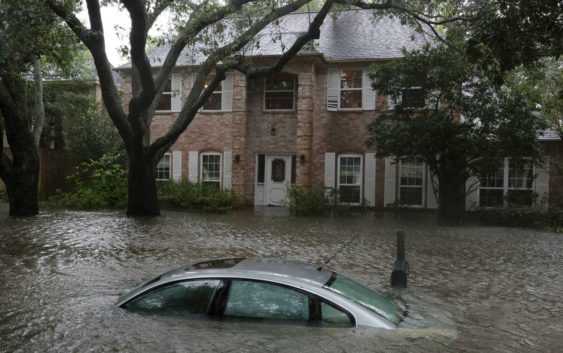- NC burn ban lifted statewide as rain improves wildfire conditions
- Western NC wildfire risk will 'get worse, not better' Ag Commissioner says, pressing lawmakers for help
- Watering trees is a must to protect them from severe weather and drought
- At least 4 dead, hundreds rescued after deadly floods ravage South Texas
- Today on Texas Standard: Deadly floods swamp South Texas, shatter records
Don't panic: Steps to take if your car sustains flood damage

,
This story was originally published in September 2019 and updated in August 2021.
Flash floods are a year-round possibility in Houston’s dense, urban environment, and can pose a high risk to residents, especially drivers.
Even if you avoid driving while it’s flooding (which you should — here’s how to prep for Houston’s dangerous flash floods), you may find a parking lot, garage or other area has flooded and left your vehicle with damage.
If your car is affected, there are some immediate steps you can take.
Here’s what the National Auto Dealers Association (NADA) recommends:
- Don’t start a flooded vehicle until a thorough inspection and cleaning is performed. Starting the car with water in the engine could cause more damage.
- Take immediate steps to dry the vehicle as much as possible to reduce the length of time vehicle components are exposed to water.
- Get the vehicle towed to higher ground if floodwaters are receding.
- Remove all moisture from the car if the interior got wet with a wet/dry vacuum. Remove seats if possible and use fans to quicken the drying process.
- Contact your insurance company or agent and promptly report the exposure of your vehicle to water or flood.
- Record the highest level of water exposure on a flooded vehicle.
- Contact a certified technician to arrange for an inspection and evaluation of all mechanical components, including the engine, transmission, axles, brake and fuel system for water contamination.
- Flush and replace all fluids, oils and lubricants, and replace all filters and gaskets for components exposed to water. While a vehicle may drive with fluids that have experienced water intrusion, extended internal exposure to water will increase the level of damage to the engine and other vehicle components.
- Many repair facilities recommend a thorough cleaning of brake parts and repacking of bearings, particularly for rear-drive vehicles. In front-wheel-drive vehicles, bearings are sealed.
- Some of today’s vehicles have padding and insulation that don’t easily release moisture. In this situation, it’s most effective to replace the materials to prevent the forming of mold or mildew that may contaminate the entire vehicle.
More Weather
- Don’t start a flooded vehicle until a thorough inspection and cleaning is performed. Starting the car with water in the engine could cause more damage.
- Take immediate steps to dry the vehicle as much as possible to reduce the length of time vehicle components are exposed to water.
- Get the vehicle towed to higher ground if floodwaters are receding.
- Remove all moisture from the car if the interior got wet with a wet/dry vacuum. Remove seats if possible and use fans to quicken the drying process.
- Contact your insurance company or agent and promptly report the exposure of your vehicle to water or flood.
- Record the highest level of water exposure on a flooded vehicle.
- Contact a certified technician to arrange for an inspection and evaluation of all mechanical components, including the engine, transmission, axles, brake and fuel system for water contamination.
- Flush and replace all fluids, oils and lubricants, and replace all filters and gaskets for components exposed to water. While a vehicle may drive with fluids that have experienced water intrusion, extended internal exposure to water will increase the level of damage to the engine and other vehicle components.
- Many repair facilities recommend a thorough cleaning of brake parts and repacking of bearings, particularly for rear-drive vehicles. In front-wheel-drive vehicles, bearings are sealed.
- Some of today’s vehicles have padding and insulation that don’t easily release moisture. In this situation, it’s most effective to replace the materials to prevent the forming of mold or mildew that may contaminate the entire vehicle.
- Don’t start a flooded vehicle until a thorough inspection and cleaning is performed. Starting the car with water in the engine could cause more damage.
- Take immediate steps to dry the vehicle as much as possible to reduce the length of time vehicle components are exposed to water.
- Get the vehicle towed to higher ground if floodwaters are receding.
- Remove all moisture from the car if the interior got wet with a wet/dry vacuum. Remove seats if possible and use fans to quicken the drying process.
- Contact your insurance company or agent and promptly report the exposure of your vehicle to water or flood.
- Record the highest level of water exposure on a flooded vehicle.
- Contact a certified technician to arrange for an inspection and evaluation of all mechanical components, including the engine, transmission, axles, brake and fuel system for water contamination.
- Flush and replace all fluids, oils and lubricants, and replace all filters and gaskets for components exposed to water. While a vehicle may drive with fluids that have experienced water intrusion, extended internal exposure to water will increase the level of damage to the engine and other vehicle components.
- Many repair facilities recommend a thorough cleaning of brake parts and repacking of bearings, particularly for rear-drive vehicles. In front-wheel-drive vehicles, bearings are sealed.
- Some of today’s vehicles have padding and insulation that don’t easily release moisture. In this situation, it’s most effective to replace the materials to prevent the forming of mold or mildew that may contaminate the entire vehicle.